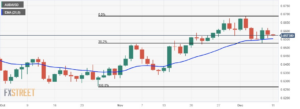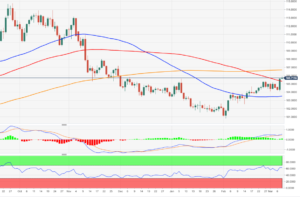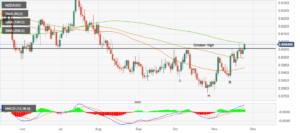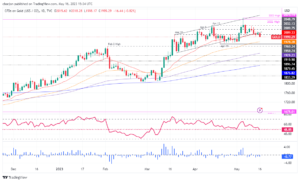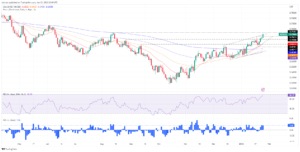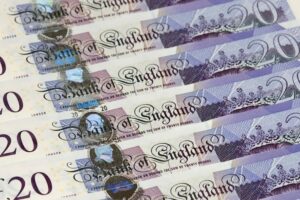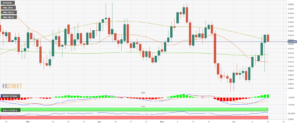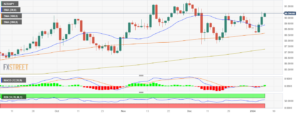- Australian Dollar hovers around a major level ahead of the US PPI, Fed policy decision.
- Australia’s Treasurer Jim Chalmers presented a budget forecast of AUD 1.1 billion in the MYEFO, down from the AUD 13.9 billion previous forecast.
- US CPI and Core CPI came in at 3.1% and 4.0% YoY, respectively, as expected.
- FOMC is expected to make no change in its policy rates.
The Australian Dollar (AUD) continues to lose ground on Wednesday, particularly after the release of moderate Consumer Price Index (CPI) data from the United States (US). The AUD/USD pair exhibited high volatility in the previous session, experiencing a modest drop after briefly surpassing the 0.6600 level. Market participants are now awaiting the release of the US Producer Price Index (PPI) and the Federal Reserve’s (Fed) Interest Rate Decision later in the North American session.
Australia’s government anticipates a significantly improved budget bottom line this year as revenues outpace forecasts. In the mid-year economic and fiscal outlook (MYEFO) presented by Labor Treasurer Jim Chalmers, a budget deficit of just AUD 1.1 billion (USD 721.4 million) in the year to end June 2024 is projected, down from the AUD 13.9 billion forecasted back in May. The government is resisting calls for additional cost-of-living handouts to avoid exacerbating inflationary pressures.
The US Dollar Index (DXY) attempts to recover recent losses amid downbeat US Treasury yields. The DXY has experienced a drop, with the Federal Open Market Committee (FOMC) anticipated to make no adjustments in its last policy decision. Inflation in the US cooled as expected in November, as indicated by the Consumer Price Index (CPI). Investors will likely closely monitor Fed Chair Jerome Powell’s comments for signals about potential rate adjustments in the coming year.
Daily Digest Market Movers: Australian Dollar moves downward amid hawkish RBA
- ANZ-Roy Morgan Australian Consumer Confidence weekly survey rose to 80.8 from the previous week’s 76.4.
- Westpac Consumer Confidence for December showed improvement at 2.7% from the previous decline of 2.6%.
- National Australia Bank Business Confidence, which surveys the current business conditions in Australia and provides insights into the short-term performance of the overall economy, declined to 9 from the previous decrease of 2.
- RBA Governor Michele Bullock expressed confidence, stating, “Don’t think we are falling behind in the inflation fight.” Bullock emphasized a cautious approach, closely monitoring data, and highlighted the RBA’s commitment to preserving employment gains.
- US Bureau of Labor Statistics revealed on Tuesday that the US Consumer Price Index (CPI) for November rose by 0.1% month-on-month and 3.1% year-on-year. Both figures aligned with market consensus, indicating that inflation levels met expectations.
- US Core CPI, which excludes volatile food and energy prices, climbed by 0.3% MoM and 4.0% YoY, in line with expectations.
Technical Analysis: Australian Dollar hovers around the major level at 0.6550
The Australian Dollar trades around 0.6560 on Wednesday. The 21-day Exponential Moving Average (EMA) at 0.6554 serves as a key support level before the significant level at 0.6550. If this support area is breached, it could exert downward pressure on the AUD/USD pair, potentially leading it toward the 38.2% Fibonacci retracement level at 0.6526. On the upside, the region around the psychological level at 0.6600 is likely to act again as a potential resistance barrier.
AUD/USD: Daily Chart
Australian Dollar price today
The table below shows the percentage change of Australian Dollar (AUD) against listed major currencies today. Australian Dollar was the weakest against the US Dollar.
| USD | EUR | GBP | CAD | AUD | JPY | NZD | CHF | |
| USD | 0.11% | 0.16% | 0.09% | 0.21% | 0.23% | 0.57% | 0.06% | |
| EUR | -0.12% | 0.05% | -0.01% | 0.09% | 0.12% | 0.44% | -0.05% | |
| GBP | -0.17% | -0.05% | -0.07% | 0.04% | 0.07% | 0.41% | -0.10% | |
| CAD | -0.10% | 0.02% | 0.05% | 0.09% | 0.13% | 0.46% | -0.06% | |
| AUD | -0.20% | -0.10% | -0.05% | -0.11% | 0.02% | 0.35% | -0.14% | |
| JPY | -0.23% | -0.11% | -0.08% | -0.16% | -0.06% | 0.33% | -0.18% | |
| NZD | -0.57% | -0.45% | -0.40% | -0.47% | -0.36% | -0.34% | -0.51% | |
| CHF | -0.06% | 0.06% | 0.10% | 0.04% | 0.15% | 0.17% | 0.51% |
The heat map shows percentage changes of major currencies against each other. The base currency is picked from the left column, while the quote currency is picked from the top row. For example, if you pick the Euro from the left column and move along the horizontal line to the Japanese Yen, the percentage change displayed in the box will represent EUR (base)/JPY (quote).
Interest rates FAQs
Interest rates are charged by financial institutions on loans to borrowers and are paid as interest to savers and depositors. They are influenced by base lending rates, which are set by central banks in response to changes in the economy. Central banks normally have a mandate to ensure price stability, which in most cases means targeting a core inflation rate of around 2%.
If inflation falls below target the central bank may cut base lending rates, with a view to stimulating lending and boosting the economy. If inflation rises substantially above 2% it normally results in the central bank raising base lending rates in an attempt to lower inflation.
Higher interest rates generally help strengthen a country’s currency as they make it a more attractive place for global investors to park their money.
Higher interest rates overall weigh on the price of Gold because they increase the opportunity cost of holding Gold instead of investing in an interest-bearing asset or placing cash in the bank.
If interest rates are high that usually pushes up the price of the US Dollar (USD), and since Gold is priced in Dollars, this has the effect of lowering the price of Gold.
The Fed funds rate is the overnight rate at which US banks lend to each other. It is the oft-quoted headline rate set by the Federal Reserve at its FOMC meetings. It is set as a range, for example 4.75%-5.00%, though the upper limit (in that case 5.00%) is the quoted figure.
Market expectations for future Fed funds rate are tracked by the CME FedWatch tool, which shapes how many financial markets behave in anticipation of future Federal Reserve monetary policy decisions.
- SEO Powered Content & PR Distribution. Get Amplified Today.
- PlatoData.Network Vertical Generative Ai. Empower Yourself. Access Here.
- PlatoAiStream. Web3 Intelligence. Knowledge Amplified. Access Here.
- PlatoESG. Carbon, CleanTech, Energy, Environment, Solar, Waste Management. Access Here.
- PlatoHealth. Biotech and Clinical Trials Intelligence. Access Here.
- Source: https://www.fxstreet.com/news/australian-dollar-moves-sideways-with-a-negative-sentiment-ahead-of-fed-decision-202312130146
- :has
- :is
- $UP
- 1
- 13
- 2%
- 2024
- 28
- 32
- 33
- 41
- 8
- 80
- 9
- a
- About
- above
- Act
- Additional
- adjustments
- After
- again
- against
- ahead
- aligned
- along
- American
- Amid
- an
- analysis
- and
- Animate
- Anticipated
- anticipates
- anticipation
- approach
- ARE
- AREA
- around
- AS
- asset
- At
- attempt
- Attempts
- attractive
- AUD
- AUD/USD
- Australia
- Australian
- Australian dollar
- average
- avoid
- awaiting
- back
- Bank
- Banks
- barrier
- base
- because
- before
- behind
- below
- Billion
- boosting
- borrowers
- both
- Bottom
- Box
- briefly
- budget
- Bureau
- bureau of labor statistics
- business
- by
- Calls
- came
- case
- cases
- Cash
- cautious
- central
- Central Bank
- Central Banks
- Chair
- change
- Changes
- charged
- Climbed
- closely
- CME
- Column
- coming
- comments
- commitment
- committee
- conditions
- confidence
- Consensus
- consumer
- consumer price index
- content
- continues
- Core
- core inflation
- Cost
- could
- country’s
- CPI
- currencies
- Currency
- Current
- Cut
- daily
- data
- December
- decision
- decisions
- Decline
- decrease
- DEFICIT
- depositors
- Digest
- displayed
- Dollar
- dollars
- don
- down
- downward
- Drop
- Dxy
- each
- Economic
- economy
- effect
- EMA
- emphasized
- employment
- end
- ends
- energy
- energy prices
- ensure
- Ether (ETH)
- EUR
- Euro
- example
- exhibited
- expanded
- expectations
- expected
- experienced
- experiencing
- exponential
- exponential moving average
- expressed
- extends
- Falling
- Falls
- FAQ
- Fed
- Fed Chair
- fed funds rate
- Federal
- Federal Open Market Committee
- federal reserve
- fight
- Figure
- Figures
- financial
- Financial institutions
- Fiscal
- FOMC
- food
- For
- Forecast
- forecasts
- from
- funds
- future
- Gains
- generally
- Global
- Gold
- Government
- Governor
- Ground
- Have
- Hawkish
- headline
- help
- High
- Highlighted
- holding
- Horizontal
- How
- HTTPS
- if
- improved
- improvement
- in
- Increase
- index
- indicated
- indicating
- inflation
- inflation rate
- Inflationary
- Inflationary pressures
- influenced
- insights
- instead
- institutions
- interest
- INTEREST RATE
- Interest Rates
- into
- investing
- Investors
- IT
- ITS
- Japanese
- Japanese Yen
- jerome
- Jim
- Jim Chalmers
- june
- just
- Key
- labor
- Last
- later
- leading
- left
- LEND
- lending
- Level
- levels
- likely
- LIMIT
- Line
- Listed
- Loans
- lose
- losses
- lower
- lowering
- major
- make
- mandate
- many
- map
- Market
- Markets
- May..
- means
- meetings
- met
- million
- moderate
- modest
- module
- mom
- Monetary
- Monetary Policy
- money
- Monitor
- monitoring
- more
- Morgan
- most
- move
- Movers
- moves
- moving
- moving average
- no
- normally
- North
- November
- now
- of
- on
- open
- Opportunity
- or
- Other
- Outlook
- overall
- overnight
- paid
- pair
- Park
- participants
- particularly
- percentage
- performance
- pick
- picked
- Place
- placing
- plato
- Plato Data Intelligence
- PlatoData
- policy
- potential
- potentially
- Powell’s
- ppi
- presented
- preserving
- pressure
- previous
- price
- Prices
- producer
- projected
- provides
- psychological
- pushes
- quote
- raising
- range
- Rate
- Rates
- RBA
- recent
- Recover
- region
- release
- represent
- Reserve
- Resistance
- respectively
- response
- Results
- retracement
- Revealed
- revenues
- Rises
- ROSE
- ROW
- s
- Savers
- serves
- session
- set
- shapes
- short-term
- showed
- Shows
- signals
- significant
- significantly
- since
- Stability
- starts
- stating
- statistics
- Strengthen
- substantially
- support
- support level
- surpassing
- Survey
- T
- table
- Target
- targeting
- that
- The
- their
- they
- think
- this
- this year
- though?
- to
- today
- tool
- top
- toward
- trades
- Treasurer
- treasury
- Treasury yields
- Tuesday
- Upside
- us
- US banks
- US Dollar
- US PPI
- US Producer Price Index
- US Treasury
- US treasury yields
- USD
- usually
- View
- volatile
- Volatility
- was
- we
- Wednesday
- week
- weekly
- weigh
- which
- while
- will
- with
- year
- Yen
- yields
- you
- zephyrnet



